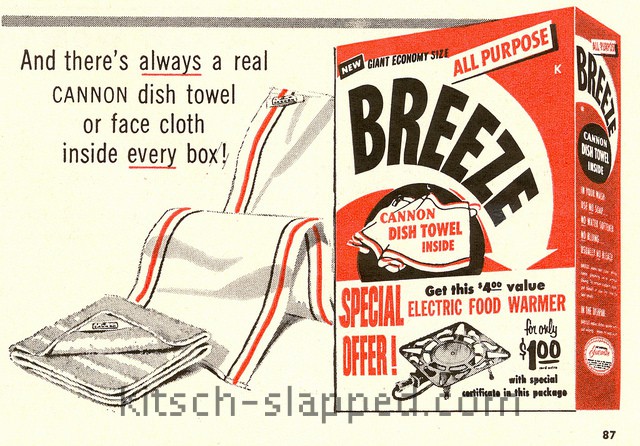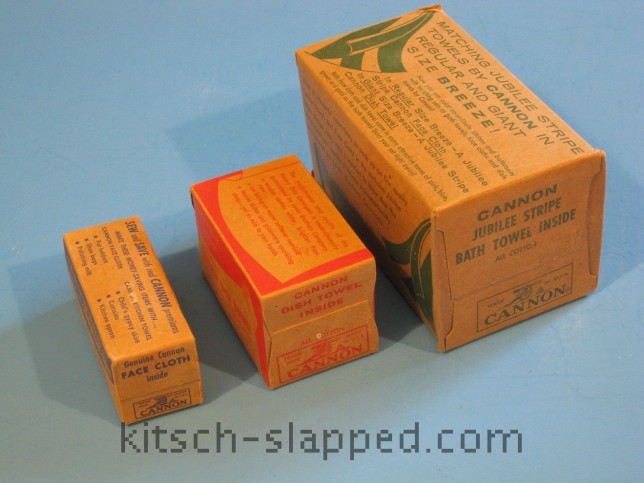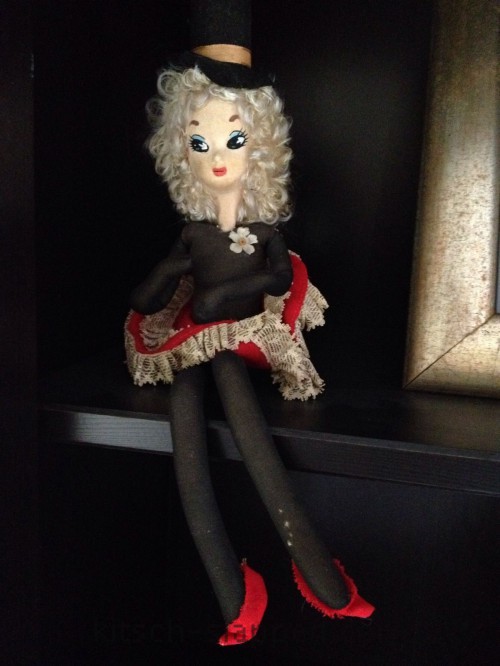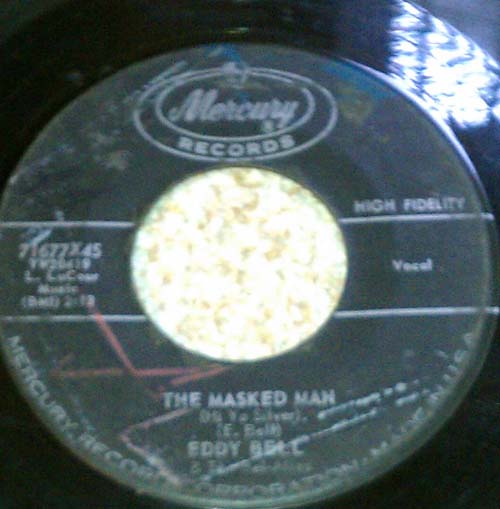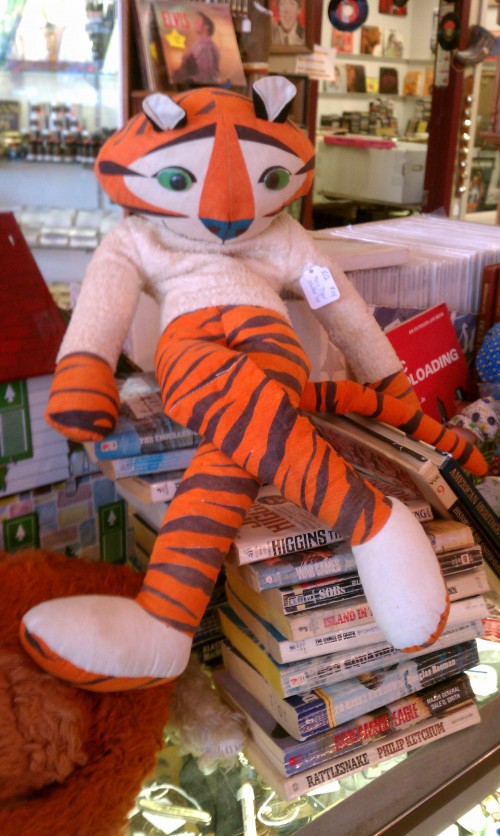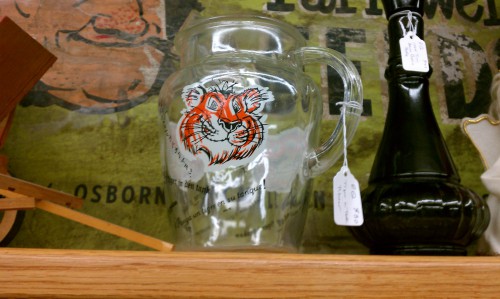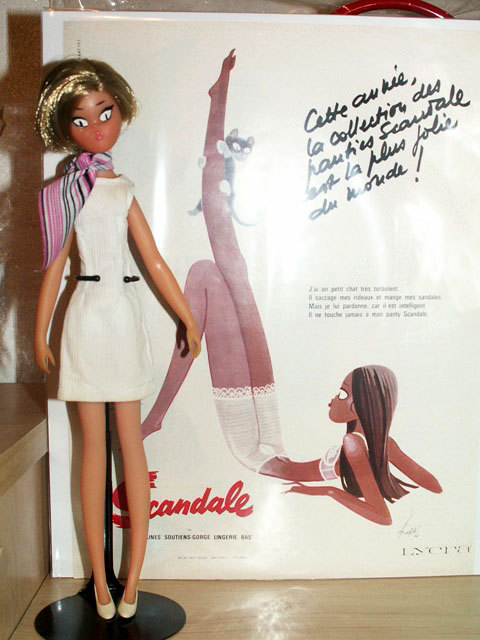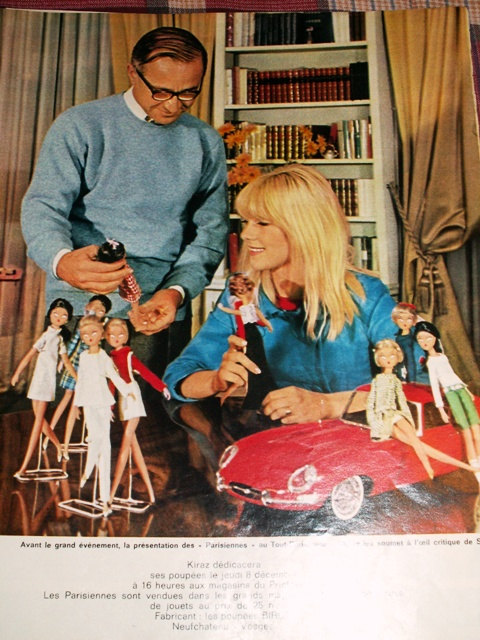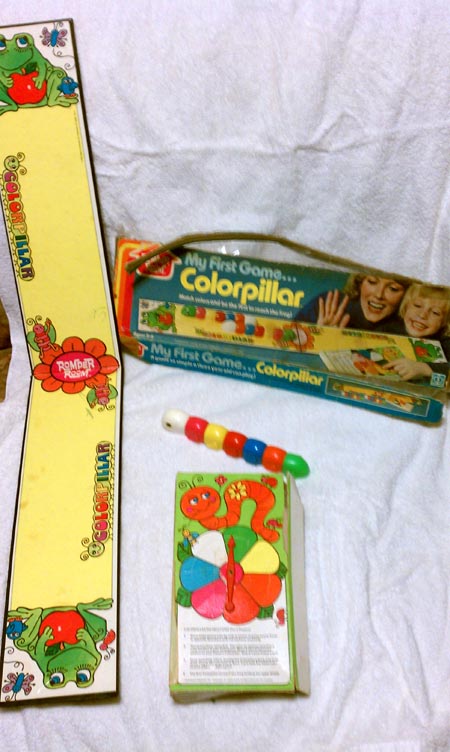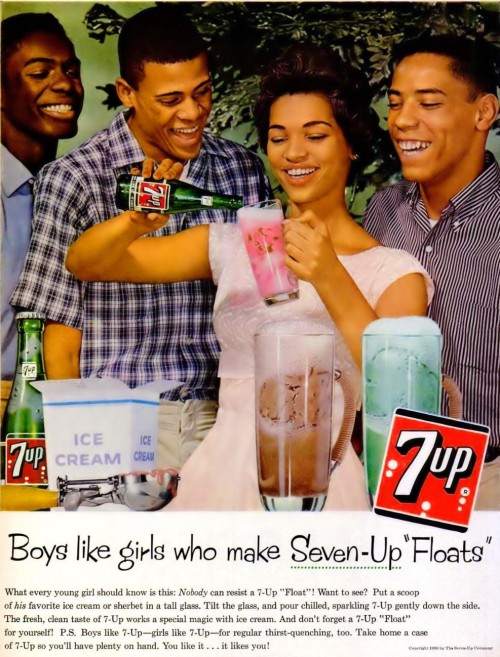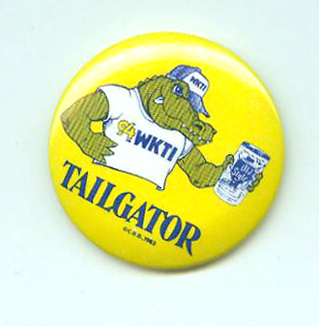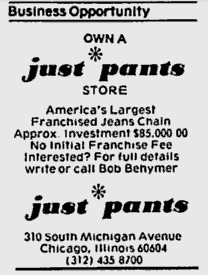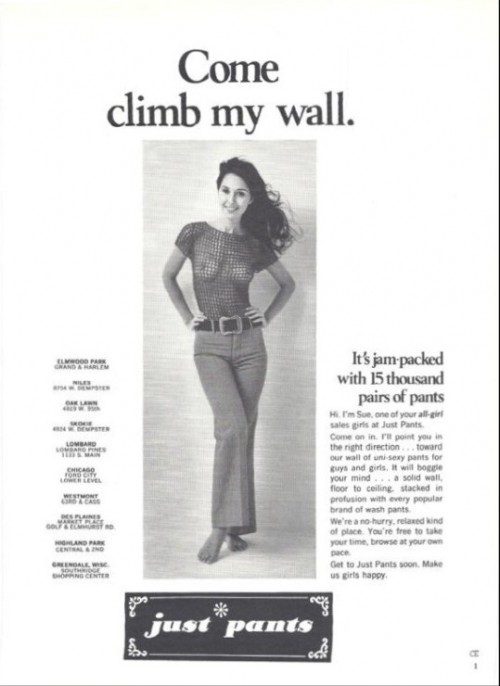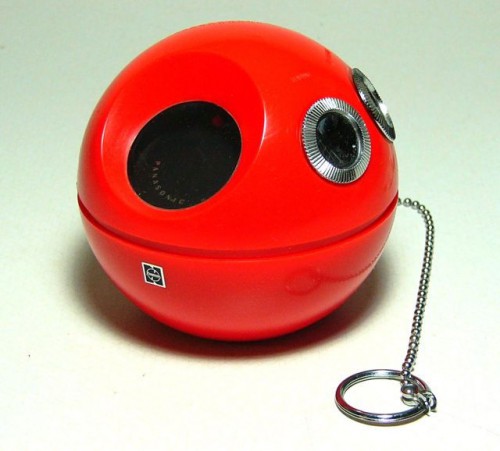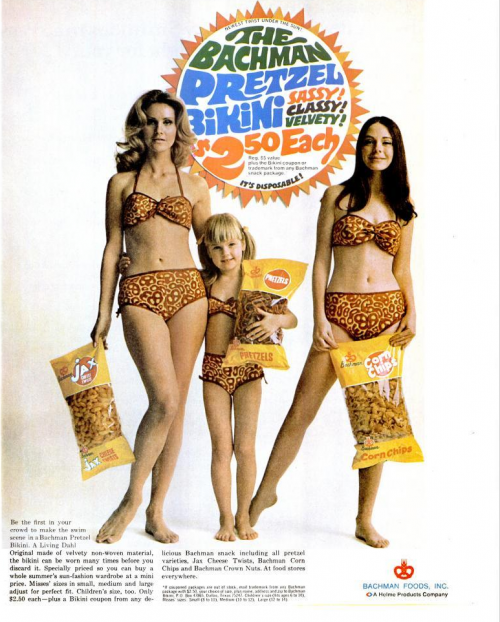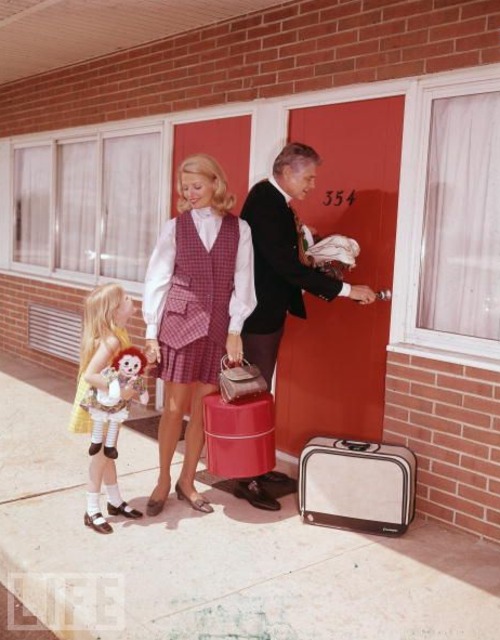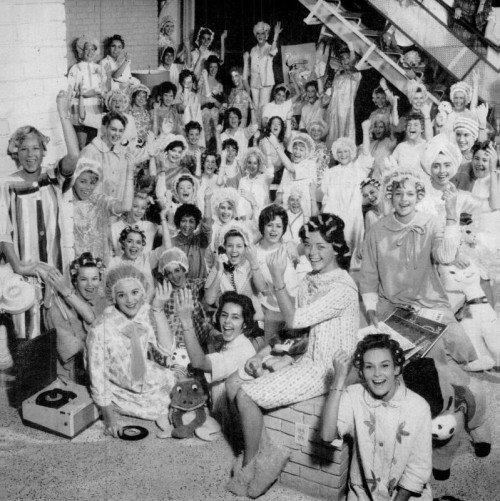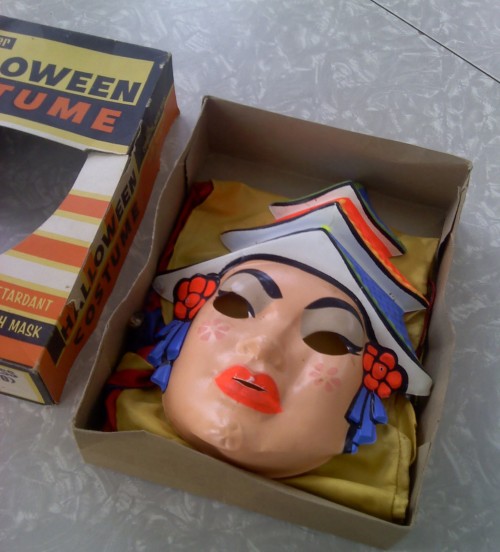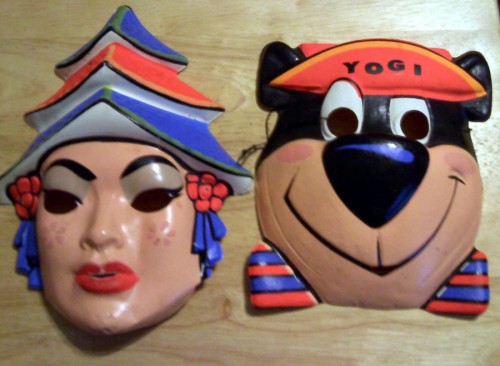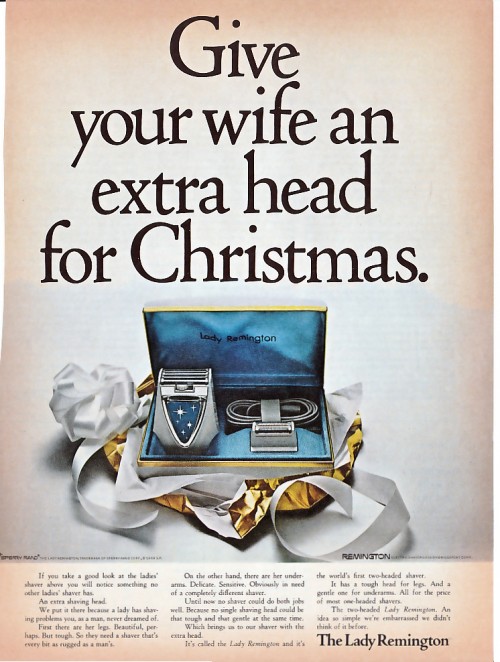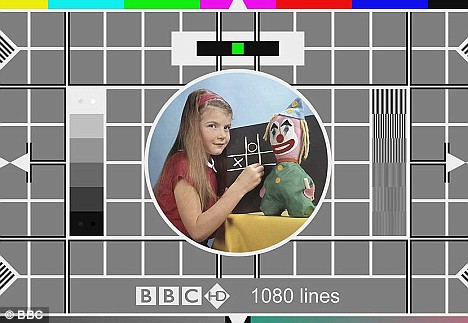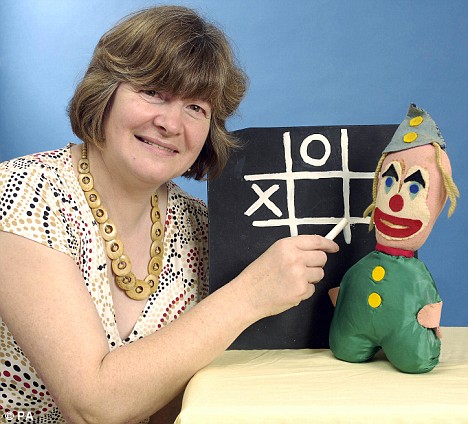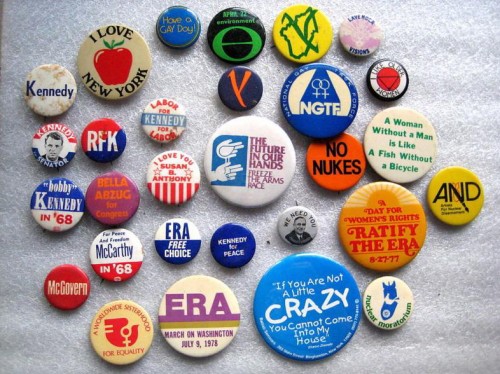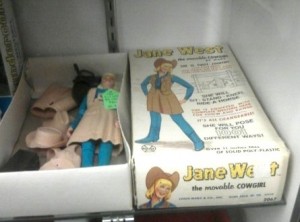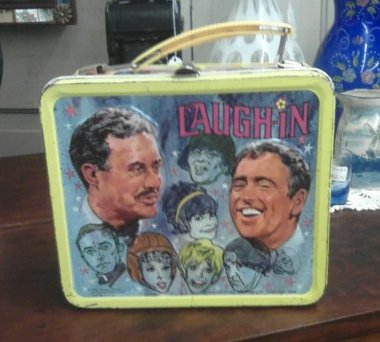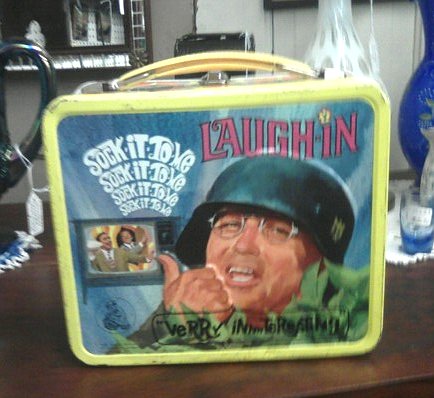I found this rather spectacularly mod commercial for Yardley’s Slicker Dollys Bus Lipsticks while researching this vintage lipstick tube. (Found via Kate Baird’s Yardley Pinboard.)
Tag: growing up in the 60s
Vintage Marketing To Women Was A-Wash In Premiums
Some people think that the only premiums that came in boxes were in cereal boxes for kids. Sure, there were those coupon books and other early loyalty programs designed to bring people back to certain department stores, gas stations, grocery stores, and other shops. But when it comes to actual free things inside boxes, most people think of the toys and surprises inside cereal boxes designed to make the kiddies beg mom and dad for the stuff. But there were other premiums, including those in products for adults. And primarily these offers were specifically aimed at those adults in charge of most household purchasing: the American housewife.
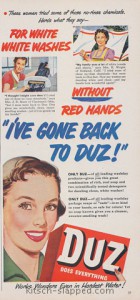 Perhaps nowhere was this push for premiums more used than in the area of laundry detergents and soaps.
Perhaps nowhere was this push for premiums more used than in the area of laundry detergents and soaps.
The competition was fierce in this market on all sorts of points, just as it is today, on everything from cleaning power and amount of suds (any real expert will tell you cleaning has more to do with physical scrubbing and agitation than chemicals and soap suds) to product versatility, and, because some cleaning still was done by actual human hands (something I still highly recommend), how gentle the product was on the little lady’s hands.
Those of us who are at least 40 years old may vividly recall these premiums and brands — not coincidentally because of the soap operas, which were, at their very essence, dramas created for housewives to watch and therefore pushed soaps and cleaning products; hence the name soap operas.
Lever Brothers, makers of Breeze laundry soap, partnered with Cannon towels for a luxury co-branded premium giveaway, eventually offering three sizes of towels.
(This stuff is apparently so nostalgic, that someone just paid $39.99 for an old unopened box of Breeze with the towel still inside.)
My mom watched the CBS soap operas, as did her mother before her. As a result, our family was loyal to the family of Proctor & Gamble products. Proctor & Gamble put towels into their boxes of Bonus laundry detergent — as this fabulous musical commercial from 1960s illustrates. Note the gender split — and how the little woman’s knowledge (and sexual necktie manipulation) wins out.
Later, P&G would graduate from towels to putting glasses and china dishes with a wheat pattern (some even with gold trim) in boxes of Duz, the “does everything” laundry detergent. Incidentally, those wheat dishes were once clogging thrift shop shelves, but now, nostalgia coupled with the fascination with Mid-Century Modern, these dishes are making a comeback.
However, when it comes laundry detergent premiums, I don’t think many things are so firmly entrenched in our collective minds as Dolly Parton pitching boxes of soap with towels in them in the 1970s. While there is some debate as to whether the brand of detergent was Breeze or Duz (it was, in fact, Breeze; and we pray again to the YouTube Gods that someone can upload such a commercial!), almost everyone recalls the ads. Especially the kitsch factor.
Dolly herself admits how corny the ads were:
I remember seeing you on “The Porter Wagoner Show,” pulling out giant towels from boxes of Breeze detergent.
It was actually a bath towel — we used to have to do our own commercials on those shows, and they were so corny. But I still have some of those towels that I’ve kept through the years. Those were the days — “And you can only get them in boxes of Breeze!” And honestly, with that towel inside, there probably wasn’t more than half a box of Breeze. But people didn’t care because they were getting something free.
Corny or not, to this day, when I see a small hand towel covered in gold roses, “zeenyas!”, or other yellow flowers I instantly think of Dolly Parton. Its not just Dolly’s love of yellow roses, but those 70s yellow florals that stick in my mind. And that’s not all. Whenever I am at someone’s house and they have a similar looking towel out for use, I am convinced my hands smell like vintage detergent too. Come to think of it, that may be why I don’t like those wheat patterned dishes either.
Shhh, It’s A Cookbook Secret…
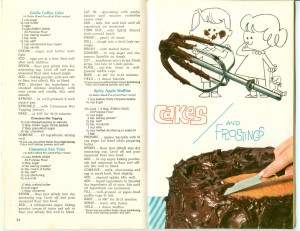 I’ve been collecting vintage cookbooks (and other ephemera) for decades. But it’s not because I actually cook. Other than baking, I nearly hate cooking. Thankfully, my dear hubby is the cook in the house. (Aside from baking and cleaning, I tend to stay out of the kitchen.)
I’ve been collecting vintage cookbooks (and other ephemera) for decades. But it’s not because I actually cook. Other than baking, I nearly hate cooking. Thankfully, my dear hubby is the cook in the house. (Aside from baking and cleaning, I tend to stay out of the kitchen.)
So what is my interest in cookbooks then?
There are many other things to be found in cookbooks, especially the vintage ones. I am particularly fond of the thrift tips and, because I am an antiques dealer as well as a collector who likes to live with old things, I find the cleaning tips quite helpful. And who doesn’t love the old graphics? But primarily my interest in the old cookbooks lies in all the cultural clues.
You can tell a lot about a culture from its cookbooks. For example, according to this 1961 Betty Crocker cookbook (Betty Crocker’s Outdoor Cook Book), there was a Mid-Century swing to putting fireplaces in homes for cooking.
A striking change is taking place in American cooking and entertaining. The backyard barbecue is fast becoming the nation’s number one hobby as, each year, more families discover that fun and good fellowship seem to double around an open fire; that nothing is more appetizing that the aroma of food grilling over glowing coals; and that the easy informality of service under the wide sky makes even the most elaborate patio party seem carefree.
The taste of charcoal broiled meats is so delicious that many of no longer let the end of summer mean good-bye to the “Cook-out.” When the snow flies, it becomes the “Cook-in” at the fireplace or at the broiling hearth now so often seen as a feature of new kitchens or family rooms.
The popularity of backyard barbecues makes sense. They are embedded images of the Atomic American lifestyle, part of the postwar attitude that creative hobbies enhanced life and “made it worth living”. But I have no recollection of this “Cook-in” phenomenon. Was cooking with real fire inside homes — not gas stoves with flames on burners, but cooking in fireplaces and on broiling hearths — a thing? (And what the heck is a “broiling hearth”??!)
Sure, I was only born in 1964 & so have little memories of the early 1960s. However, if so many homes had such things as fireplaces and hearths for cooking, they still would have existed in the 1970s. As a kid, I went in and out of a lot of homes… Extended family, friends, the neighbors… And none of them had these cooking hot spots.
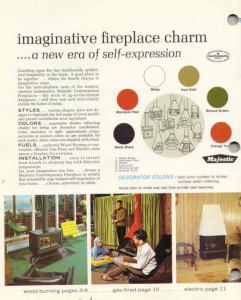 Sure, there was the whole retro mod fireplace thing (which mainly was a home decor “You had the money for that?!” statement piece), but the closest to cooking that fireplace got was when the fondue pot and accoutrement was placed on the coffee table near it. (Majestic, Malm
Sure, there was the whole retro mod fireplace thing (which mainly was a home decor “You had the money for that?!” statement piece), but the closest to cooking that fireplace got was when the fondue pot and accoutrement was placed on the coffee table near it. (Majestic, Malm, & Preway were the names in Mic-Century Modern fireplaces.)
Should General Mills be telling the truth, and not having Betty blow some marketing sunshine up my apron, there are other reasons that I likely know nothing of this “cooking with fire in the home phase” of American life. Primarily this boils down to the socioeconomic status of my life.
We were Middle Class folks, yet not the Upper Middle Class sort who were building their own homes. Plus, in my family, my mother worked — as in she had a career. Cooking was no longer her main focus — if it ever had been. (I married a man like Dear Old Dad, one who cooks!) As a result of all of this, the trendy “cook with fire inside” thing likely was a trend my parents were neither interested in nor one they likely could afford. (We were, however, early adopters of the microwave oven.)
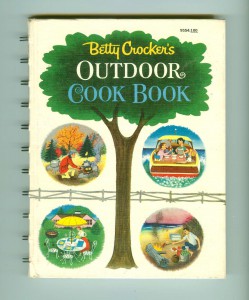 Thanks to a number of things, I really have done no better in socioeconomic terms than my parents. To keep it simple, I am a 99%-er. While I am in the midst of slowly restoring a century old house, I have no plans for internal cooking with fire options. (I am no cook, remember?)
Thanks to a number of things, I really have done no better in socioeconomic terms than my parents. To keep it simple, I am a 99%-er. While I am in the midst of slowly restoring a century old house, I have no plans for internal cooking with fire options. (I am no cook, remember?)
Anyway, while we slowly restore that house, we live in a very small house — and too much stuff. So, we are downsizing, including our personal collections. (In part why I have been so quiet at this blog; it is time consuming work!) This means that I am currently listing a lot of my antique and vintage cookbooks in our Etsy shop. And other items from my other collections, such as vintage and pulp paperbacks, will be there soon too. Along the way, I will do my best to share interesting tidbits from these items here and at my other blogs (see links under “Deanna Elsewhere”).
Vintage Can-Can Made In Japan Doll
Vintage can-can dancer Holiday Fair Doll by Hedaya & Co. NYC, made in Japan. For sale here, from stainedglasssonia.
Some Of You May Recognize This Song As Hi-Ho Silver Away
In celebration of the new Lone Ranger film (with the usual semi-racist depictions of Tonto, this time played by Johnny Depp), we dug out our copy of The Masked Man by Eddy Bell & the Bel-Aires. Since TheRodge76 already did the work of uploading it to YouTube, my work here is done. (Though now that we are digging through the old vinyl, lord knows what will show up in our online shops and in our spaces at the antique stores; so keep an eye out.)
Whatjamacallits Wednesday: Tigers In Your Tank Edition
Back when I was a kid and I didn’t understand intellectual property such as sales & marketing slogans; hence, I never understood why Kellogg’s didn’t just come right out and have Tony The Tiger say that Frosted Flakes cereal was the tiger in your own tank. I was reminded of this upon sight of this vintage Tony The Tiger stuffed toy.
To me, a tiger was a tiger — and really just as cute. (Don’t you just love the Exxon tiger on this glass pitcher?)
And fuel was fuel, even if cars had less “taste” to worry about.
I sill feel rather the same way today about both tigers and fuel. Even with a better understanding of slogans, marketing, and intellectual property. That knowledge, combined with my usual obsessive streak, has since led to the discovery that it was Kellogg’s who first unleashed their tiger (in 1951). Exxon’s tiger arrived in 1959. So perhaps it was Exxon executives who ate cereal and felt the connection between breakfast fuel and gasoline for cars.
Both of these item are for sale. I am an antiques dealer, you know. (Also on Facebook.) You may also contact me about them, if you are interested.
I Bet You Think I’ll Hate This
But I actually quite like this vintage Scandale lingerie advertisement with artwork by Edmond Kiraz.
Impossibly long legs don’t bother me — when they are part of fashion illustration. As Slip of a Girl writes, “Illustrated ads do not run the risk of starting or perpetuating body dysmorphia or forms of self-hating body loathing because we know they are illustrations — no one looks like that. But we can pretend to…”
The female depicted as feline, while cliche, isn’t a real bother either; women have relationships with cats, like it or not.
But perhaps the best thing about this vintage ad is what I learned: Kiraz made dolls. Fashion dolls based on the artist’s Les Parisiennes series, to be precise. What Kiraz himself calls the “effigies of his work made by Birgé-Jopo”.
Often called Poupee de Kiraz or Les Parisiennes dolls by Kiraz, these 15 inch tall French fashion dolls seem to have only been made for one year, in 1967. That makes these little gems difficult to find. And playing hard-to-get does so turn me on as a collector. I am now on the look-out for these vintage vinyl fashion dolls from France. The ones with the round faces, cat’s eyes, and impossibly long and slim legs. So period. So fascinating.
All images via GGSDolls.
The Political Shades Of A Colorpillar
When I grabbed this Romper Room Colorpillar toy, I had vague memories of the Romper Room TV show…
But not enough, apparently. A quick look at the Wiki entry and it turns out this toy is most fitting for this political season.
First, there’s the whole problem with children’s television shows and hosts pitching product during shows. Romper Room was the first target of the newly formed watchdog group Action for Children’s Television who leveraged the power of an threat FCC threat into ceasing “host-selling”.
Then there’s the whole Romper Room abortion scandal.
In 1962, the hostess of the Phoenix franchise of Romper Room linked her own name with that of the ongoing controversies over abortion. Sherri Finkbine, known to television viewers as “Miss Sherri”, sought hospital approval for abortion on the ground that she had been taking thalidomide and believed her child would be born deformed. Finkbine made a public announcement about the dangers of thalidomide, and the hospital refused to allow an abortion, apparently because of her announcement and its own fear of publicity. Finkbine traveled to Sweden for the abortion. Upon completion, it was confirmed that the fetus had no legs and only one arm. The incident became a made-for-TV movie in 1992, A Private Matter, with Sissy Spacek as Finkbine.
I guess this really is an educational toy — if you research it, rather than play with it.
In terms of memories of the show, as I said, they are fuzzy. Not all warm and fuzzy; just not clear. Also according to Wiki:
The hostess would also serve milk and cookies to the children, with prayer offered before eating. The famous Romper Room prayer went “God is great, God is good. Let us thank him for our food. Amen.”
Now that’s the prayer I remember saying. But that’s really odd, because our home was not a praying home. Perhaps this praying business is why I don’t recall much of the show… Perhaps when my folks found out prayer and indoctrination was part of the program, they switched the set off. That is something I will have to ask them.
Happy Birthday Me
Birthdays are a time of reflection — but don’t worry, this isn’t one of those sentimental personal pieces full of beauty and gratitude, a wistful and wise piece about aging, or even one of those sad yet triumphant stories of survival. While I have moments of deep gratitude, brief bits of wisdom, and small moments in which I feel triumph sits on the horizon like a ship I can see and might one day board, I’m still working on all those things.
Instead, this birthday is like most birthdays since I was to turn 16. That year I told my parents that I didn’t need or deserve a party; I had achieved nothing and they deserved the credit for having kept me alive. Today I feel rather the same — only with a much heavier sense of futility. For in 48 years, neither the world, my status in it, nor my feelings about it has changed much.
I was born on June 21, 1964; I joined this world, as Michael Schwerner, Andrew Goodman and James Chaney left it. My mother’s screams may have been dulled by the twilight sleep of that time’s hospital deliveries, but I passed through the same veil, entered the ether echoing with the agony, pain, and fear of those men, their families and friends, and all who possess any shred of humanity… And I have lived in a country filled with those sounds and the stink of racism ever since.
I was born white; but such privilege doesn’t preclude the ability to know how wrong racism is, to hate what separates and enslaves. …To feel the futility of such efforts even to educate that we the privileged have an obligation to do what is right is a heavy rope around my own neck.
I was born a girl; I joined this world with my rights up for debate and my womb under the control of others men. Any progress towards equality and the right to my own person has been met with struggle, abated with state allowed terrorism, and, indeed, is being wrestled away as I sit here today. Such abuse, rape, and control by the state fills me with the same pain, indignity, helplessness, and shame as the abuse, rape, and control experienced at the hands of individuals. …And then there are the more subtle, less violent, means of control — disrespect, dismissing, muzzling, belittling, economic inequality, shaming — used to assert government control, which perpetuates the abuses by individuals.
I was born “straight”; but, like being white, I know that my privilege of heterosexuality obligates me behave as a human being towards my fellow human beings. Ostracization and inequality based on orientation &/or gender identity is still in practice, in vogue in some places. It sickens, saddens, and wearies me as if it were my own personal struggle. …Then again, since this is very much tied to male power, beliefs about sexuality, it really mirrors — nay, is, my personal struggle.
I was born without silver spoon in mouth, or nearby. My parents worked tirelessly to provide a better future for their children. It was achieved; but brief. Those born with silver services and gold flatware have worked just as tirelessly to ensure that the poor and middle class would assume their place at the feet of their economic masters. I now work tirelessly to ensure my children survive; “thrive” is a question which lies under the boot heels of social and economic masters — i.e. wealthy white men and their corrupt corporations which are allowed human status.
Survival isn’t as easy as it sounds.
So you’d think I could hang my proverbial birthday hat on that, give myself some credit for just having made it to 48.
But I am just too tired.
Too tired to even go, as is my birthday custom, and visit graveyards and cemeteries. For when I see how the nuns who gave their lives in service and faith are buried like paupers, adoringly facing the monuments of their male leaders — presumably to serve even in death, I cannot bear the energy such emotion evokes. Not even when I see that the little cement slabs which mark where the nuns lay are less lavish, less cared for, than the markers for the never-born, the aborted. Really? Are female lives given in such service worth so little that they must still be treated as less-than virtual beings, ideas of beings?! It’s all just too-too much.
A lifetime of so little progress is just too much.
Celebrating John Glenn’s Legacy
Speaking of John Glenn orbiting the Earth…
NASA’s Glenn Research Center will commemorate the 50th anniversary of John Glenn’s orbital flight in Friendship 7 by hosting an event, Celebrating John Glenn’s Legacy: 50 Years of Americans in Orbit, at 1 p.m. EST on March 2, 2012, at Cleveland State University’s Wolstein Center, 2000 Prospect Ave., in Cleveland.
Here’s a rundown of the celebratory event program:
NASA Administrator Charles Bolden and Glenn Director Ramon “Ray” Lugo will provide remarks during the one-hour program, which will include a welcome from Cleveland State University President Dr. Ronald Berkman. Space shuttle mission STS-95 pilot Steve Lindsey will pay tribute from the astronaut corps to Glenn. The program will culminate with a keynote address by the guest of honor Sen. John H. Glenn Jr.
Musical performances will be provided by the Cleveland Institute of Music, The Singing Angels and a soloist from Cleveland State University’s music program. Doors open at noon and a special pre-program musical performance by the Cleveland Institute of Music will begin at 12:15 p.m., followed by a video tribute to Glenn.
…Others attending the tribute event include agency officials, Ohio astronauts, NASA employees and contractors, elected officials, several hundred high school students throughout northeast Ohio, and 100 Twitter followers selected to participate in a day-long Tweetup event that includes tours of NASA Glenn and its visitor center at the Great Lakes Science Center.
After the official program, Glenn, Bolden and Lugo will participate in a Q&A session with the lucky Tweetup participants.
More than 800 complimentary tickets are being distributed to the general public for this event through a lottery by Cleveland State University in partnership with NASA Glenn. But don’t worry if you don’t win the lottery — the program will also be carried (streamed) live on NASA Television online. You might miss some swag and photo ops, but you can still see the event as it happens!
What Every Young Girl Should Know
Boys like girls who make Seven-Up “Floats”
What every young girl should know is this: Nobody can resist a 7-Up “Float”! Want to see? Put a scoop of his favorite ice cream of sherbet in a tall glass. Tilt the glass, and pour chilled, sparking 7-Up gently down the side. The fresh, clean taste of 7-Up works a special magic with ice cream. And don’t forget a 7-Up “Float” for yourself! P.S. Boys like 7-Up — girls like 7-Up — for regular thirst-quenching, too. Take home a case of 7-Up so you’ll have plenty on hand. You like…it likes you!
Hey, look, it may be sexist, but it also tells girls how to avoid giving boys head — on their 7-Up “Floats” (forever in quotes) and later, their beers.
Copyright 1960 by the Seven-Up Company; via.
Of Tailgators, Radio & Retail
This is a vintage WKTI Tailgator pinback from 1983, featuring Old Style beer. It’s mere 1.75 inches, but oh the size of the memories it unleashes…
If you’re of a certain age — and from the Milwaukee, Wisconsin, area — you remember this era of WKTI, Reitman & Mueller — and the uncomfortably named Jim “Lips” LaBelle.
Thinking of WKTI reminds me of the days our family ventured into the retail business. We bought into the Just Pants franchise, running the Just Pants store at Southridge Mall, then a Taubman Mall (Taubman married and divorced from Christie Brinkley, a rather too present icon of my life, helping me date nearly anything).
Our biggest Just Pants competitor was the County Seat — and Kohl’s department store (which bled we specialty jean stores to death by using Levi’s and Lee denim loss leader sales). Anyone else remember the days of denim walls so high, sales staff used ladders to reach the goods? That’s the pun behind this sexy Just Pants ad — it predates when we had our store (and I doubt we would have ran the ad ourselves, even if it had been in the creative pool of franchisee options.)
Anyway, in that era we not only often played WKTI in the store but we special ordered and custom hemmed Bob Reitman‘s black boot-cut Levi’s. Yeah, we were that cool.
Back then, we not only played whatever radio we wanted in the store, on July 13, 1985, we played the Live Aid broadcast in the store. I called in from the store to donate, getting myself an official Live Aid t-shirt. (They were out of my size, so I received a size small which wouldn’t have covered The Girls and so it has remained safely packed away all these years.)
Now, WKTI is WLWK, “Lake FM.” (Reitman’s still kicking it on air with his weekly show, It’s Alright, Ma, It’s Only Music.) And, ironically, Lake FM sounds almost like an auditory time capsule of the Reitman & Mueller days. I know, I’ve listened to the station when I’ve traveled home. Old habits die hard and my fingers still “dial” to the stations I recalled. Not that any of them are there anymore. Lazer 103, QFM, LPX… All long gone. Apparently, after I moved from Wisconsin, the radio station marketplace went to hell. I’m not the only one who’s more than nostalgic; check out 93QFM: The Halcyon Daze for Milwaukee Rock Radio DJ Stories.
This got me thinking about the other radio stations & DJs… And the connections to retail.
Marilynn Mee, aka Jackpot Girl, part of Bob And Brian’s morning show on Lazer 103 (Mee may still be on WKLH?), was someone I met quite often when I was working at the Estee Lauder counter at Gimbels. Mee was pals with Pam, who worked Lancome. I envied Mee her wardrobe of all things. But then, if you’ve ever had to wear the cosmetic girl garb, well, you’d understand it. Hard to feel 80-‘s glam when you’re wearing a turquoise smock-tent, no matter how fab your face and hair look. (Despite the fact that Marilynn and Pam partied with rock stars, I was the good girl who found herself knocked up; an entirely different subject, and I’ve digressed too much already.)
Because I’m all nostalgic about radio…
My first radio love was WOKY — and AM station that then played top 40 pop stuff. It came in loud and clear on my red ball Panasonic R-70 transistor radio.
I would turn the volume up and dance madly in the back yard. My most vivid memory is of cranking up Billy Preston’s Go Round in Circles and dancing on top of the old wooden picnic table. So not safe, I’m sure, even if you weren’t dancing yourself dizzy goin’ round in circles. Ahh, those were the days, though.
http://www.youtube.com/watch?v=un63LEAN22E&noredirect=1
Image Credits: Vintage 1970 Just Pants ad via Ads-Things4Less. Panasonic photo via ebyauctions.
This One’s For My Dad
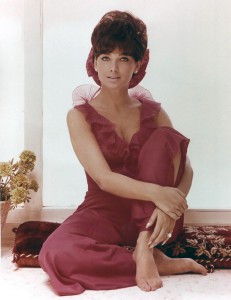
This photo of Suzanne Pleshette reminds me of my dad.
My dad had a thing for Suzanne. He also had a lusty crush on Susan Anton. We used to tease him maybe variations on “Sue” was his real “thing.” *wink*
As a young girl, and then a young woman, those two women were so disparate… And neither resembled my mother.
…Well, maybe my mother was a bustier Pleshette, with a more dulcet voice.
But anyway, my point is, my daddy taught me early on that men can be attracted, simultaneously, to many things about women — that there wasn’t necessarily a “type,” either for one man or mankind. That’s the sort of thing a woman needs to know. And it doesn’t hurt to know that such crushes or affections do nothing to demean or diminish the loving and lusty committed relationship one’s in, either.
I was reminded, again, just how important dads are to girls when hubby and I helped dad run his booths selling antiques at Cedarburg Maxwell Street Days this past weekend. Dad’s sort of got a carnival-barker-meets-stand-up-comic style to his manning of his booths. (Another thing I’ve picked up from Dad!) One woman, drawn in by Dad’s quick wit, was instantly charmed — not only by my dad, but by my relationship with him.
“It’s clear you love your dad,” she said. Tears formed in her eyes — and mine — when she said, “I lost my dad 26 years ago… Dads are so important in their daughters’ lives…”
Damn right they are.
So here’s to you, Dad. Enjoy Ms. Pleshette. Thanks for being you.
Forever indebted,
your daughter
The Bachman Pretzel Bikini
Hey, edible underpants, you had competition… The Bachman Pretzel Bikini.
Just $2.50 for a “classy” and “sassy” two-piece bikini of “velvety non-woven material.” I can’t imagine you could swim in it. Nor can I imagine wanting a crunchy edible item of apparel — which the words “pretzel bikini” rather imply. Perhaps non-woven means edible? Plus the obvious “good enough to eat” cliche, which the pretzels then lend to the women, and kids, who wear it…
In any case, what’s the use of such a novelty item that “can be worn several times before you discard it”? Pure schtick promo, that’s definitely in bad taste no mater how you look at it.
Via this post at Found In Mom’s Basement.
Have Hairdryer, Will Travel
This vintage travel photo is awesome on its own, but it’s also a culmination of many posts I’ve made today! (Hint: That means all but one of the the links are to my posts at other blogs. It will be like you traveling with me!)
Life magazine posted it at Tumblr, saying:
Hostel? Clean? Those two words in the same sentence? Wow, what a foreign concept for many of us— let’s take a trip back to When Hostels Were Clean (yes, once upon a time they were clean…)
We want to hear from you: tell us about your worst hostel experience.
I don’t think this is a true hostel; it looks like a motel. I would also accept the inaccurate use of hotel. But not a hostel. It’s not just my experience which says so; I look at a lot of (and post a lot) of vintage travel images. But in any case, note how mom has her portable hairdryer in hand. Americans probably wouldn’t bother to bring a hairdryer to a hostel… However, you would bring one before you bring a child.
Speaking of vintage hairdryers…
Traveling with one is preferred over packing your vacuum. Even if it can clean and double as a hairdryer.
Anyway, I’m lovin’ following Life at Tumblr (this is me at Tumblr, in case you wanna follow me there); I also posted this about Life’s contest tomorrow.
What Time Is It?
According to this ad for Bulova watches, it’s time for a pajama party. Circa 1963; via Simple Dreams.
Confessions Of Culture Shifts & Gender Bias
Sometimes being 46 years old — and a woman — is an amazing thing. I’m often fascinated by the cultural shifts I’ve witnessed; too often dismayed by the cultural shifts promised which have not occurred, been set further back even… But it sure has been a shifty four decades.
I often wonder if other individual women in other generations have anything to compare…
I’ve thought my Great Aunt M had lived through some amazing changes — suffrage, working during WWII and returning back home when the men came back to claim “their” jobs, the choice not to have children in the atomic family age… Amazing cultural shifts in one lifetime.
I’ve long been aware of my mother’s experience — but usually from the point of view of what it’s been like to have been her daughter. She was the first and only mom I knew who consistently worked outside of the home. At first it may have just been for the money; waitressing and the like. But by the late 70’s she was progressing from “just an office job” to reading The Assertive Woman, attending workshops on how-to-dress-for-success, and actively pursuing a career. As the only kids in the neighborhood — and in our family — with a wanting-to-work mom (and a father who supported her choice and her work), my sister and I had a different perspective of women’s lib: equal parts of liberation, greater responsibilities, and increased expectations. …This could be a long post by itself.
But just a few days ago I had an astonishing talk with my mother which made me reexamine just what it must have been like for her…
 She and I had been discussing how different my sister and I are (I’ve always said that if we hadn’t been born sisters, we never would have met), and I said, “I could understand it better if she and I had been born further apart, but there’s only a year and a half separating us — we were raised by the same parents, at the same time in their lives.”
She and I had been discussing how different my sister and I are (I’ve always said that if we hadn’t been born sisters, we never would have met), and I said, “I could understand it better if she and I had been born further apart, but there’s only a year and a half separating us — we were raised by the same parents, at the same time in their lives.”
And then that’s when my mom shared some stories that rocked my brain.
When my mom was in high school, this would be the late 1950s, she wanted a summer job. Her father said he would recommend her to the diaper washing service next to his auto-body shop if she promised to work every single day — not miss one day, or ever be late. She agreed, he made the recommendation, and she got the summer job.
She went in to work every day, all summer long. Then one night, she and her boyfriend — her first love, broke up. She spent all night crying, as teenage girls will do. When she woke up and her father spotted her in the hall, he asked her why she wasn’t yet dressed for work. She responded that she was a mess, that she could barely see through her puffy eyes, that she wouldn’t be going into work that day. Her father looked directly at her, said, “You gave your word,” then turned on his heel and left.
Mom quickly got dressed and to work on time. She never missed one day of work and lived up to her word.
When it came time for her younger sister Vickie, mom’s junior by nine years, to get a summer job, Vickie only worked four days before she quit. Years later, when having some sister-chat, my Aunt Vicki asked her sister, my mother, “Why didn’t they teach me to be responsible, like they did you?”
My mom’s response was, “You came along at a different time in their lives; you were their baby and they had different expectations of you.”
That is probably a fair analysis. And an amazingly insightful, non-spiteful, response from my mother to boot.
But my mom wasn’t done sharing her stories.
A few years after the summer laundry job, my mom worked full-time as a secretary at a finance company. This was at the same time that her brother, Mike, just two years her junior, was working at Pabst. My mom was paying $15 a week in rent to her parents. She thought nothing of it until she discovered that her brother wasn’t paying anything to their parents.
When she asked her parents why she paid rent and her brother did not, the answer (given in that “you’re so silly to ask” tone of condescension) was that “she was working for pin money, but Mike was a man.”
Even though “Mike the man” wasn’t supporting a family (his paycheck went to purchase beer), the assumption was that he was working for a future, that his paycheck and job were more important. He was expected to work; she was not. The price for her frivolity in dabbling in employment was one she would have to pay for.
Even now when I think about this I am amazed. Not just that this greatly shifts my perception of my beloved grandparents, who were a product of their own times, but that my mother who was raised by and living with these people had the guts to question her parents about this gender bias.
But that’s not even the worst of it.
When I expressed my surprise and shock — including that I’d never heard these stories before, my mother shared one more…
This one is about my cousins, Lisa & Danny, who are my Uncle Mike’s kids.
Recently, my cousin Lisa was out to lunch with my mom and she confessed that both she and her brother felt they never pleased their father; Danny for not being a macho sports guy — and Lisa for not being a boy at all. It was so bad that Lisa said, “You know, my mom never read to me. Not once. She read to Danny.” And then she rapidly tacked on — as if risking being accused of being unfair or mean-spirited, “I could listen though.”
Images of a small shy child silently lurking in the doorway while a mother snuggled with a sibling on a bed, reading to him from a book he’d selected… *shudder*
I always wondered why my cousin Lisa was so shy — painfully so. Ill-confident, uncomfortable in her own skin. How can you be anything else when your own parents don’t think you’re worthy of being read to because you’re not a male child?
It sounds the stuff of the 1950s, not the 1960s and 70s… If “America” at all.
But here it is, gender bias bullshit, from real lives, not text book depictions; from my family, some of it even in my lifetime. It’s real. It’s still living here, if only in echos. And poor self esteem.
Image via Steady Mom.
Before There Was Princess Jasmine…
There was this Chinese Princess costume and mask by Ben Cooper.
OK, so maybe she’s not exactly a dead-ringer for Princess Jasmine. And so what if I get more of an Indonesian-vibe than a Chinese one; we could debate such things all day. But not debatable is the fact that this princess is very fair. I also have the vintage Ben Cooper Yogi Bear costume and mask (I also have it up at auction on eBay), which is, if not the same shade, a bit darker.
“Give Your Wife An Extra Head For Chirstmas”
An ad from 1969 that likely couldn’t be published today:
OK, so it reads “an extra head,” not just “extra head” or just plain old “head,” but still, ad execs today would just know what we’d be reading into the buzzing gift of a Lady Remington.
Lady Remingtons, by the way, were quite popular gifts, judging by the number of them found at garage sales, thrift stores, etc. So this ad may have sent just the right message after all. *wink*
BBC Resumed Clowning Around
We Americans (at least those who watched NBC) had Marjorie Hellen, color TV “identification girl”; across the pond, BBC watchers had “Carole and the clown” test pattern.
The test pattern, featuring eight-year-old Carole Hersee, was broadcast between 1967 and 1998, amounting to 70,000 hours of screen time — and in January of 2009 that test pattern returned. The BBC has rescanned the original transparency in high definition to help consumers set up the latest TV sets.
Below is a photo of Carole Hersee in 2009, when she was 49.
(Mini) Signs Of The Times
A lot of 30 feminist and gay/lesbian pinbacks, including pro ERA pins and “I Love You Susan B. Anthony.”
Jane West: The Movable Cowgirl
I have a mild interest in the Johnny West toys by Louis Marx & Co.. Like so many retro toys, it’s really rare to find them with their original boxes; so when I saw Jane West with her box in a display case at a local antique mall I had to take a closer look…
Is it just me, or does the wording on the box, “Jane West The Movable Cowgirl” and “She Will Pose For You 1001 Different Ways”, sound erotic?
Hubby says it’s just that Marx marketed their toys differently than most. They weren’t dolls and they weren’t action figures. What he said next rather removed them from the toys category too: “If Marx were making things today, they’d be seen as made for the collector market.” So, if they aren’t for kids to play with, they’re adult toys.
Which intriguingly brings me back to Jane “posing for me” in 1001 ways…
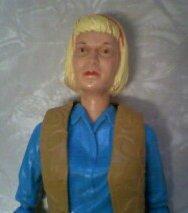 Johnny West may have been a fighter, but he was a lover too. At least my Johnny was (and I couldn’t have been the only one doing this) so I know from personal experience of playing with Jane and Johnny that many of the poses were most unnatural. So many joints on Jane provide a flexibility that Jenna Jameson would envy.
Johnny West may have been a fighter, but he was a lover too. At least my Johnny was (and I couldn’t have been the only one doing this) so I know from personal experience of playing with Jane and Johnny that many of the poses were most unnatural. So many joints on Jane provide a flexibility that Jenna Jameson would envy.
Maybe that’s why there were so few female figures made by Marx… If you’ve got one bendy cow girl willing to pose for you in so many ways, why bother with another? Sure her face wasn’t real pretty, but how many of the poses meant you actually had to look at it?
Besides, one bendy chick — with blonde hair yet! — was already luring too many of those Indians.
The Verrry Interesting Laugh-In Lunch Box
Growing up, Rowan & Martin’s Laugh-In was on too late for me to stay up & watch; it began airing in 1968 when I was just four. But hearing my parents talk about the show, I wanted to see it in the worst way. So eventually my whining bore fruit; mom sent me to bed with my younger sister, but as she tucked me in she whispered in my ear, “Just pretend to sleep — I’ll come back and sneak you out past your sleeping sister before the show starts.” I was so excited!
But that must have been too much excitement for me because mother found me passed-out, sound asleep, when she came back for me — but my little sis was awake and she got to watch the show! Drat! Just another reason for a little girl to dislike her little sister.
As the show ran until 1973, I eventually grew old enough to stay up and watch it — not that I understood most of it. Laugh-In was a show built on political humor and sexual innuendo; not something your average kid knows. Well, I understood enough to know there was naughty stuff… and most of the cultural comments were even further over my head. But Arte Johnson was wacky enough for me to genuinely giggle at.
All of this came flooding back when I spotted this old Laugh-In lunch box at a local antique mall this past weekend.
It was a delight to spot — but I carefully replaced it up on it’s lofty spot on a shelf when I spotted the $125 price tag. (Which, apparently, is not out of the norm for such retro Laugh-In lunch boxes.)
But what really makes this find noteworthy is the fact that Rowan & Martin’s Laugh-In was not a television show for kids — so why make kids’ lunch boxes?
I mean kids didn’t understand the show — and by the time they would have, wouldn’t they be too old for lunch boxes with thermoses? I can imagine the beating 16 year olds took for toting mom’s PB&J in a lunch box.
So just who were these lunch boxes with “Sock it to me” on them marketed to? Kids who, like me, wanted to watch the show because their parents thought it was cool? Parents, who wanted their kids to look cool?
Well, it seems to me that in the late 60’s to early 70’s parents didn’t push their kids to look like mini-adults like they do today… And while there weren’t the same judgments & finger pointing at parents for kids having risqué knowledge (hey, back then we kids traveled in cars without seat belts, even riding on those backseat ‘shelves’ under the rear windows, and we kept our parents company in taverns without any finger or tongue wagging), parents hadn’t yet given into the permissiveness of letting the children dictate to them, especially about adult things. We sat in taverns because parents wanted to go, we rode in the car that way because no laws yet forbade it, and we got Disney and Muppet stuff because we were kids.
It was just that sort of upbringing which makes me covet such a lunch box. It’s familiar & nostalgic, but it was never mine because I was too young — now that I’m older, I want it bad.
